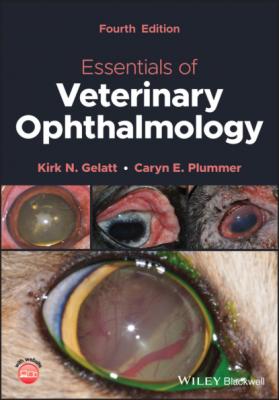Essentials of Veterinary Ophthalmology. Kirk N. Gelatt
Чтение книги онлайн.
Читать онлайн книгу Essentials of Veterinary Ophthalmology - Kirk N. Gelatt страница 47
 Optic nerve
Optic nerve
a If sufficient cortex of one cerebral hemisphere is damaged, the menace reaction cannot be elicited in the contralateral eye of the dog. Pathology of the cerebellar cortex can also affect the menace reaction.
b The menace response can also involve turning the head or moving away from the stimulus.
Table 2.2 Blinking rates of domestic animals.
| Species | Blinks/min | Interblink period | Concurrent blinks (%) |
|---|---|---|---|
| Dog | 3–5 | 20–30 sa | 85 |
| Cat | 1–5 per 5 min | 18.5 s | 70 |
| Horse | 19 | 77 | |
| Cattle | 5 | 60 | |
| Pigs | 10 | 90 |
a Dogs have partial blinks every few seconds between complete blinks.
Blinking and blink rates have been studied in many species under varying circumstances and methodologies, making comparisons and generalized statements difficult (Table 2.2). Blinking does not occur randomly, and blinks are often associated with gaze shifts and saccades. One of the theories for this timing is that blinking temporarily blocks visual information, and blinking during gaze shifts and saccades takes advantage of blocking vision when the images are already degraded from movement. Diurnal nonhuman primates and birds have higher blink rates than nocturnal nonhuman primates and birds, and in general, larger mammals and primates blink more often than smaller mammals. Blink rates and evaporation of the PTF can affect topical drug activity.
Eyelids in the Dog
In dogs, the larger upper eyelid, which contains the cilia or eyelashes, is more mobile than the lower eyelid. When the eyelids are closed, most of the ambient light is prevented from entering the eyes. Restrained dogs blink 10–20 times/min in comparison to unrestrained dogs. Some 50% of dogs' blinks are incomplete. Puppies normally open their eyelids between 10 and 15 days of age.
Eyelids in the Cat
In cats, both eyelids lack cilia. The eyelids of pigmented cats allow no more than 5% of light at longer wavelengths to be transmitted. Kittens normally open their eyelids between 10 and 15 days of age; however, both eyes do not always open on the same day.
The NM of the feline species is large and active, but in most other species it moves passively. In cats, it actively covers most of the cornea; it can extend at least two‐thirds of the way across the cornea and contains nine smooth muscles that lead to active retraction or protrusion. These smooth muscles draw the membrane into the medial canthus and are innervated exclusively by postganglionic adrenergic sympathetic nerve fibers, with cell bodies located in the anterior cervical ganglion. Their axons follow the oculomotor nerve. Normally, the NM shows no spontaneous activity in most species, because the smooth muscle lacks tight junctions like those of the visceral smooth muscle. Each muscle cell is innervated by one or more axons, thus confirming that activation of the smooth muscle in the NM is neurogenic and that the myogenic conduction normally found in visceral smooth muscles does not occur. Thus, cats are the only common domestic animal in which sympathetic stimulation will cause the NM to move.
Other Species
Horse
In horses, the cilia are long and numerous on the upper eyelid, except near the medial canthus. Horses blink at about 19 blinks/min, approximately one‐third of which are minimal incomplete, one‐third of which are moderate incomplete, and one‐third of which are complete, with only 6% of the blinks having a complete squeeze. Lid closure is approximately twice as rapid as lid opening. Eyelids are open at birth. Also, long tactile hairs, or vibrissae, are present on both the dorsal brow and lower eyelid. The vibrissae are long, stout, single shafts of hair that are usually thicker than adjacent skin hair; they may provide additional sensation for the eyelids.
Cattle, Sheep, and Pigs
In cattle, sheep, and pigs, the upper eyelid is the most mobile, largest, and has the majority of cilia. Pigs, rabbits, rodents, and some ruminants have a deeper separate structure, the Harder's gland or harderian gland, in addition to the superficial gland of the NM. This gland secretes lipids, porphyrins, indoles, and growth factors, and is thus also important for lubrication of the eye. In the pig, the meibomian glands are poorly developed, and the primary eyelid glands are sweat glands. Eyelids are open at birth in these species.
Birds and Reptiles
In birds and certain reptiles, the lower eyelid is larger and more mobile than the upper eyelid. There are no feathers corresponding to eyelashes on the lids. The superciliary line refers to feathers that correspond to the eyebrow and are often of different colors than surrounding feathers. The superciliary or supraorbital ridge refers to the unfeathered bony protuberance just dorsal to the orbital rim that is seen in many raptors, such as eagles and hawks. The ridge is thought to provide shade to the eye. Birds may blink with both eyelids or the NM alone. In contrast to mammals, the thin nearly transparent NM of birds is under direct skeletal muscular control with two muscles extraneous to the lid that can pull the NM over the entire cornea as many as 15–20 times/min, even with the other eyelids closed. Blinks in peacocks are strongly associated with gaze shifts. The NM also contains a superficial tear gland, and some species have a deeper harderian gland. Chicks hatch with their eyes open.
Tear Production and Drainage
Both the optical and normal functions